Curacao travel plans should be in your travel list for 2023. The Island is an ideal destination for all types of travelers, including families, couples, girls’ trips, group trips, and more, with a variety of activities, beaches, and things to do. It is located in the southern Caribbean Sea, 40 miles north of Venezuela, between the islands of Aruba and Bonaire. Aruba, Bonaire, and Curacao are the three islands that comprise the ABC Islands. It’s vibrant culture and one-of-a-kind experiences offer travelers a marvelous, mind-opening trip beyond the sublime, crystalline waters of the surrounding Caribbean Sea.
Since 1816, the country has been a part of the Kingdom of the Netherlands and a key port for international trade. The Dutch have left their mark on the island, particularly in its architecture. Among the many other influences on the country are Spanish (it was first a Spanish territory)
This autonomous country in the Dutch Caribbean is a must-visit for island lovers who want a rich cultural experience as well as incredible architecture and vibrant art, exciting culinary experiences (including the opportunity to taste the iconic Blue Curaçao liqueur straight from the source), and unforgettable deep-sea adventures.
Due to their history, most Curacoans speak a variety of languages. Most native speakers are fluent in Dutch, English, and Papiamentu. The official language is Dutch, but Papiamentu is the most widely spoken. Most Curacaoans speak Spanish, and English is widely used.
The island serves an interesting collection of cuisines that reflect its diverse culture and history. It serves dishes from the Netherlands and Indonesia, as well as Venezuela and the approximately 50 other nationalities who call Curaçao home. Taste your way through Curaçao’s varied culture with dishes like Indonesian beef stew, funchi fries, stuffed cheese, and more.
Because Curacao is located outside of the storm belt, it has a sunny and dry climate with little rainfall all year. Even though it is great to visit all year round, the best time to visit Curacao is during the off-peak season, from May to November. You’ll find the lowest airfares and room rates during these months.
Direct flights from the United States are available, as is a connection to Curacao. The cheapest and fastest way to get to Curacao from Miami is by flight, which takes 5h 16m and costs $700 – $1200. Check our prices below to get cheapest tickets from Miami to Curacao.
We’ve provided a travel guide from Curacao with places you can stay, top attractions, and things you can do. Take your time to go through in order to have an easy trip and vacation.
Best Curacao Destinations
1. Willemstad
Willemstad is the island’s capital city, and it has historical sites, beaches, impressive architecture, and a lively atmosphere. Along the waterfront, you’ll find an array of colorful buildings that showcase the city’s charm, as well as plenty of shops and restaurants to visit.
The historic center and waterfront are both designated UNESCO World Heritage sites, so you won’t have to travel far to find impressive historical sites. There is also impressive architecture, such as the Queen Juliana Bridge and the Queen Emma Bridge, which is also known as the Swinging Old Lady. This town encompasses the majority of the island’s southernmost region.

2. Jan Theil
Jan Thiel is a beach resort with soft sands, inviting waters, and an array of unique restaurants that offers all the fun activities you could want on a relaxing vacation. There are four restaurants near the beach, and each one has something unique to offer. Choose the chef’s surprise; it never disappoints.
You can get an ice-cold cocktail whenever you want at this location because drinks are easily accessible. Nothing beats a satisfying drink for soaking in the fresh sea air and relaxing ambiance. Experience it for yourself along the coast south of Willemstad.
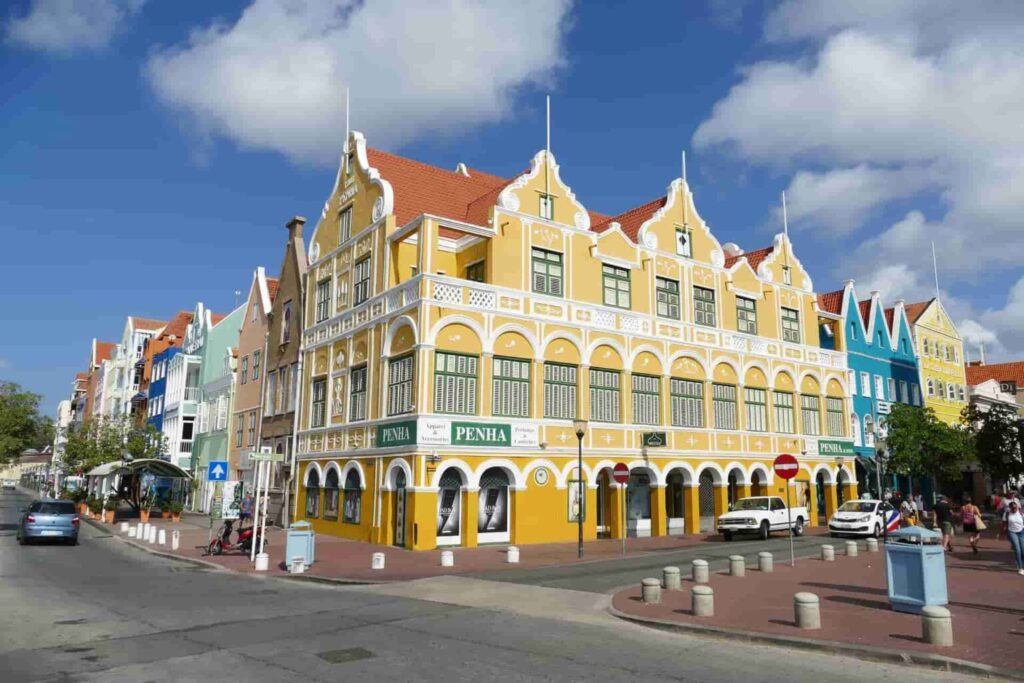
3. Sabana Westpunt
Sabana Westpunt has a variety of beaches that are ideal for your vacation, whether you want to relax or go on some aquatic adventures. Many of the local beaches, such as Playa Kalki and Playa Forti, are notable for their coral sands, though beaches such as Playa Grandi are more popular with fishermen.
You can go scuba diving off the coast if you want to really explore the water. All of the necessary equipment is nearby, making it simple to explore the local reefs and even a sunken plane wreck. This area is located in the island’s northwestern corner.

4. Sint Michiel
Sint Michiel is a small fishing village with a fishing pier, seafood restaurants, nature trails, and a dive club on the beach. Because there isn’t enough sand for a traditional beachfront experience, fishing is the most popular pastime here.
The restaurants in this village serve some of the best seafood on the island, prepared with fresh ingredients that are often caught just a few steps away from the kitchen. This area also has a salt marsh that you can explore, as well as a trail that provides stunning views of the area from its endpoint. This village is located on the island’s west coast, near Bullenbaai Bay.

5. Soto
Soto is a small inland town with rolling green hills, a peaceful atmosphere, and historical sites you won’t want to miss. Because there are no buildings here, the landscape is particularly vibrant and visible. Trees and green foliage can be found throughout the town, including on the main street.
When you visit, there are plenty of places to unwind, whether you go for a walk or drive through the peaceful backroads. You can even go inside a heritage building. Sato is located in the island’s northwestern corner, just east of Santa Martha Bay.

6. Piscadera
Piscadera is a beautiful town with a beachfront resort that offers luxurious experiences such as water sports, scuba diving, and spa massages. There are over 60 scuba and snorkeling sites in the area, so you can go on an extended underwater adventure if you want.
There are opportunities to relax on the white-sand beach or in the spa area with a professional massage within the resort area. There is even an 18-hole golf course nearby. This resort is located a few miles west of Willemstad, around the bay of the same name.

7. Sint Willibrordus
Sint Willibrordus is best known for its historic church, but there are also impressive natural features to explore, such as salt pans and bays. The church here is the village’s crowning jewel, with an imposing neo-Gothic architectural design dating back to the late nineteenth century.
There is plenty of nature to explore around this village, including glistening salt pans that appear to glow in the sunlight. Flamingos are also common in this area. Playa Porto Marie and Daaibooi Beach are also nearby. The village is located near the island’s western coast, just north of the island’s center.
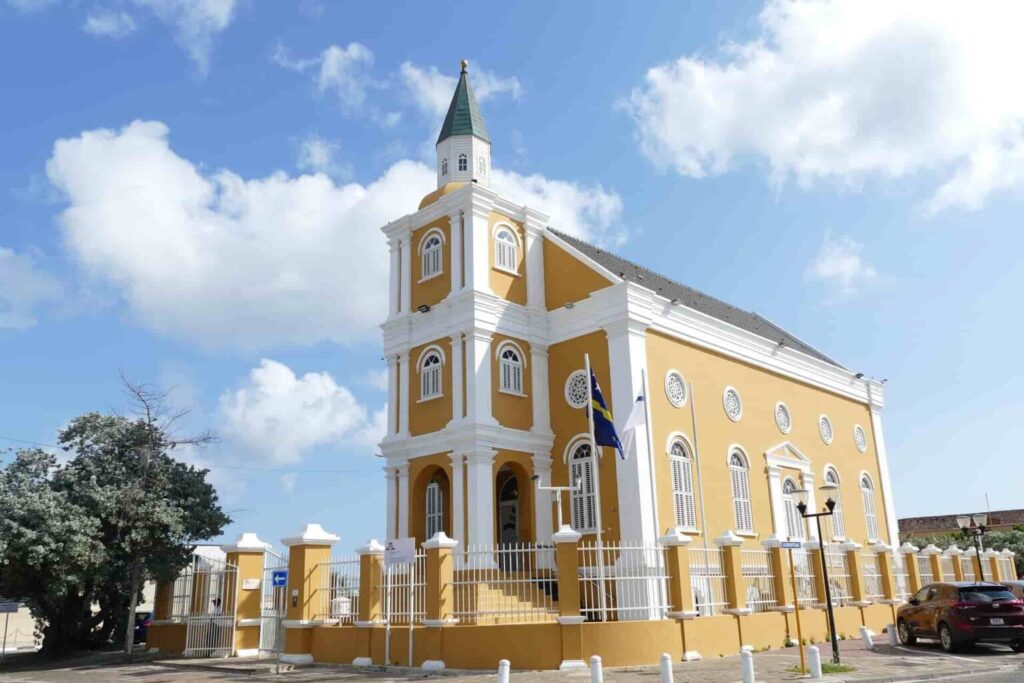
8. Tera Kora
Tera Kora, which translates to “red earth” in Papiamentu, is a small town with everything you need for a relaxing vacation on the island, from shops to beach access. The supermarket, cafés, and restaurants are especially popular here, so don’t be afraid to visit their colorful structures.
It’s simple to get to the beach from here; simply head northeast. Most of the rentals are conveniently located near the beach access area, so you may find yourself close to the water. It’s all in the center of the island.
Take a break and listen to our podcast on one of the the topmost destinations in the Caribbean: Jamaica
Hotels and Accommodations you can stay for Curacao Travel
1.Curacao Havila Beach Hotel
Take your vacation to another level at the Avila Beach Hotel! In this luxurious beach resort, you can relax in the full-service spa, in the outdoor infinity pool, or just by simply laying on the private beach club. Make sure to take advantage of the several amazing activities offered: go scuba diving, swim with dolphins, and play a game of golf at a nearby golf course
2. Curaçao Marriott Beach Resort
Have a dreamy vacation in this stylish and elegant beach resort, offering the typical warm Caribbean hospitality. With its amazing location only 5 minutes walking from historic Willemstad, the resort offers 2 outdoor pools, private ocean-front villas, and both local and international restaurants!
3. Lagoon Ocean Resort
Build memories of a lifetime in this dreamy beach resort, offering beautiful private villas with views on the Caribbean turquoise waters! Relax at Lagoon beach, only a short walk away, enjoy snorkeling with turtles, and finish your day with a delicious dinner at the nearby local restaurant! The perfect place for families or romantic vacation!
4. Papagayo Beach Hotel
Have the ultimate luxurious stay in this stylish boutique hotel within walking distance from Jan Thiel beach. Wake up in your private room with a breathtaking ocean view, start your day with a nutritious American breakfast, relax in the spa during the day and have fun at the casino at night!
5. Lions dive beach resort
This luxury, eco-friendly resort will spoil you with four delicious restaurants, three outdoor pools, a relaxing wellness center with a spa, and an exciting Ocean Encounters premier dive shop! Take advantage of its great position and go check out Mambo Beach Boulevard’s shops, bars, and restaurants, all within walking distance from the resort.
Things to do in Curacao
1. Take a walk in the historic city of Willemstad
Curaçao’s capital, Willemstad, is the island’s historic center and the most photographed location. The historic district is also a UNESCO World Heritage Site. It’s a great place to start your tour of the island. You can easily see all of the attractions in a single day because they are all within walking distance of one another.
Begin your day with a view of the Handelskade and the iconic Queen Emma Bridge, “Our Swinging Old Lady.” This bridge, built in 1888, connects the quarters of Willemstad, Punda, and Otrobanda. The Handelskade is a colorful depiction of the Dutch influence on the island. In the past, these vibrant structures served as commercial hubs. The best view of these two landmarks is from Otrobanda. After admiring the Queen Emma Bridge and the Handelskade, pay a visit to the nearby Curaçao Museum, Kura Hulanda. This museum will take you on a journey through the history of slavery, but it will also take you all the way back to Africa.
After doing a tour at the Curaçao Museum, Kura Hulanda will head back to the Queen Emma Bridge and cross the bridge. Walk past the Handelskade towards the Floating Market. The Floating Market is a market where Venezuelan merchants come by boat to sell their produce. They stay for a short period of time and then return to Venezuela. In front of their wooden boats, they have stalls with either fish, fruits, or vegetables. Sometimes, they even sell cookies, chocolates, or other sweets from Venezuela. Buy a cocosete as a snack to go. It’s a delicious cookie made of coconut.

2. Experience the Best Beaches in Curacao
Curacao offers one of the most pristine beaches in the Caribbean. The water is electric blue. The sand is white and powdery. And the coastline is picture-perfect. With dozens of beaches—each with its own distinct personality—Curacao has a beach for everyone.
Here are a few you should visit:
- Playa Knip: The turquoise waters are perfect for swimming. The coastal landscape is stunning. And on most days you can find a batidos stand with delicious fresh-fruit smoothies to cool off. But the best part is parking and admission are free.
- Playa Lagun is one of the most picturesque beaches on the island with colorful fishing boats. But the real beauty is below the surface. Playa Lagun’s water is crystal-clear, making it perfect for spotting colorful reef fish, corals, sponges and sea turtles.
- The Avila Beach Hotel’s grounds are definitely a place to visit. The resort’s private beach features chaises loungers under parasols and palapas, or small tiki huts. With so many shade options, you can stretch out all day. With a colorful, frozen drink in hand of course. Head to the boat-shaped Schooners beach bar for delicious beach drinks and eats.
- Porto Marie is Curacao’s best-in-show beach. It has plenty of chairs in the shade to relax, vibrant, blue water for swimming and snorkeling plus a floating platform for kids. But the best feature is the mega-long pier that’s great for snapping vacation photos.
- Klein Curacao or “Little Curacao” is a tiny, uninhabited island eight miles off the coast of Curacao. You can book a cruise with Mermaid Boat Trips to visit the island during the day and experience this remote paradise practically all to yourself. The beach is long and pristine and the island has an old lighthouse to explore. Under the surface, there are incredible snorkel spots such as an abandoned shipwreck site and underwater caves.
- Shete Boka Park isn’t the beach you come to for typical beach activities, but it’s worth a visit. The park’s 10 pocket beaches are home to several species of sea turtles but most people go to see the water. Giant, mesmerizing waves crash onto the rocky coast. If you go, wear a rain jacket and bring a waterproof camera! At low tide, you can walk into the caverns carved by waves, explore tidepools and set out stacking rocks.
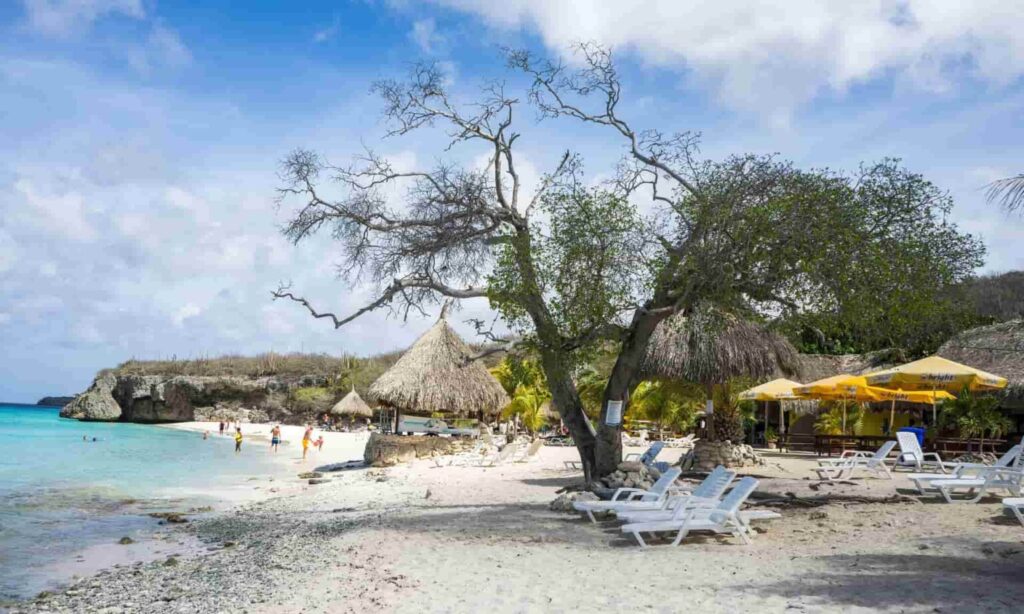
3. Hike in the Christoffel National Park
The Christoffel Park is the national park of Curacao, harboring a rich variety of local flora and fauna. Visit the park and enjoy the beautiful nature and outdoor activities. You can also hike the 372 meter high Christoffel Mountain. There are many ways to explore the park at your own pace and time; however, if you are looking to dig a little deeper into the history, flora, and fauna of the park, we recommend that you join one of the guided hikes or Jeep safari) tours!
Climbing Christoffel Mountain is one of the most popular—and more advanced – hiking trails in the park. You can also visit the Savonet Museum located in “Landhuis Savonet” inside Christoffel Park. Get inside information and a peek into the lives of the former inhabitants of the area! In the exposition: Nos Naturaleza,” you’ll find out more about nature. Nature lovers will find the park teeming with birds and plants. You will probably see species that are not easily seen elsewhere on the island! The park harbors a rich variety of local flora and fauna.
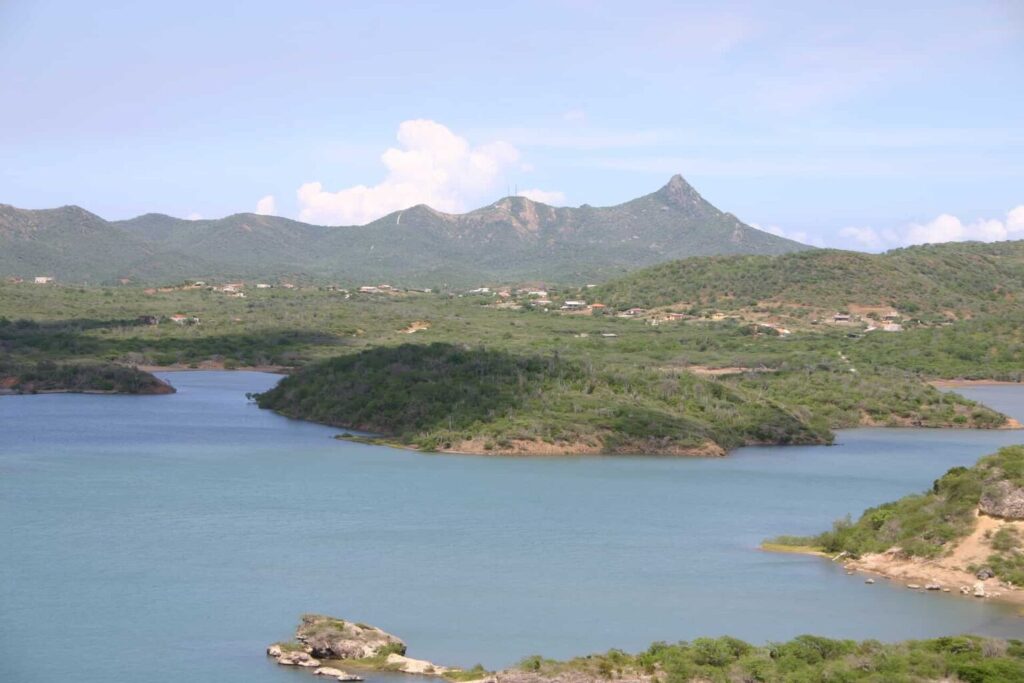
4. Taste the island’s game-changing liqueur
The Genuine Curaçao Liqueur is produced at Landhuis Chobolobo. Take a guided tour of the distillery to learn how the famous orange and blue liqueurs are made (using the dried zest of a special variety of bitter orange, laraha, which grows only in the Caribbean) and how they have influenced cocktail culture today.
Invented in 1896 by the Senior Company’s first director, Edgar Senor, it inspired a slew of cocktails, including the Blue Lagoon and Blue Hawaii, as well as its use as a key ingredient in classic margaritas. The liqueur, which is infused with spices such as cloves, cinnamon, and nutmeg, has a strong orange flavor with a slight bitterness.
In addition to tasting the famed liqueur in its original form, you’ll enjoy signature frozen cocktails crafted by mixologists in the charming courtyard bar. Bring a bottle or two home to remember your fantastic time on the magical island of Curaçao—you’ll savor the journey with each sip.

5. Dig into delicious, adventurous, only-on-Curaçao cuisine
It’s no surprise that Curaçao offers a diverse range of culinary experiences—the delectable mix reflects the country’s diverse culture and history. Eat your way around the island, sampling dishes from the Netherlands, Indonesia, Venezuela, and the many nationalities that call Curaçao home.
The traditional Caribbean stew, karni stoba, is indigenous to the island. The seared meat—marinated with pepper and garlic and cooked with peppers, onion, tomato, and spices until tender and stick-to-your-ribs thick—is a great way to refuel after a day of exploration. Steamed green papaya chunks and potatoes add a hearty touch. It’s available at restaurants all over the island, including De Gouverneur on the Otra Banda side of Willemstad.
Adventurous eaters can also dig into a plate of yuana, an iguana stew, a staple of the island’s cuisine for which Jaanchies Restaurant is famed. For a sophisticated dinner, head to Serafina for the red snapper, which is pan-seared and dressed with a delicate lemon sauce.
There are numerous other ways to tantalize your tastebuds from morning to night. To fuel up for a day of culture and exploration on the island, visit the “Snek” stands for coffee, pastries, and sandwiches. These charming street-side cafes abound in Willemstad. And, for the past 30 years, food trucks have been operating on Curaçao, long before it became a trend elsewhere. At the bustling food truck scene, open daily from 9 p.m., try the island-style barbeque such as sweet, tender ribs, barbecued chicken, and more. BBQ Express is a neighborhood favorite.
Watch the YouTube video below from ViewCation to explore other amazing things to do in Curacao.
Getting Around Curacao
Driving is the best way to get around Curaçao. Some hotels on Curaçao provide area shuttles, and public buses cover the majority of the island, but service is infrequent, particularly outside of Willemstad. If you want to explore the island on your own time, you’ll need your own vehicle. Taxis are available from Curaçao International Airport (CUR), which is about 8 miles northwest of Willemstad. Cabs, on the other hand, can be costly, especially if you plan to use them frequently.
Check with your hotel to see if it provides airport transportation. Otherwise, a one-way taxi ride from the airport to Willemstad will cost around $30.
By Car
If you intend to explore outside of major urban areas such as Willemstad, renting a car is a worthwhile investment. Car rentals can be expensive, but you are not required to keep the vehicle for the duration of your stay. You can rent a car at the airport; Alamo, Avis, Budget, Dollar, Hertz, and Thrifty are among the major car rental companies represented. There is also a dense concentration of car rental agencies on the island’s eastern side, near the cruise ship terminal. Rates vary depending on the season and the company, but you should budget between $39 and $69 per day. Your US driver’s licence is sufficient for driving in Curacao, according to the US State Department.
Taxi
Taxis are convenient for short trips around Willemstad, but longer journeys and island tours will drain your wallet. Taxis in Curaçao are not metered, but drivers may have rate sheets for various destinations. A cab ride to the island’s northwestern tip will cost you between $80 and $100. Cab drivers raise fares by 25% before 6 a.m. and after 11 p.m., or if you have more than four passengers. Taxi drivers also expect a 10% tip. It is best to agree on a fare before getting into the cab.
Bus
Curaçao has a limited public transportation system. The large “Konvooi” buses provide transportation throughout Willemstad, with stations in Punda and Otrobanda. Convoys, on the other hand, only run about once an hour during the week and even less frequently on weekends. Convoys will also take you west, but service along these routes is limited (every two hours or so). One-way fares vary, but are typically 2 guilders (about $1.15). You can also take the smaller “buses” (actually nine-person vans labelled “BUS”), which run more frequently than the convoys but on an ad hoc basis.
Curacao Travel Requirements
Visa Requirements
Upon arrival in Curaçao, you must have:
- a U.S. passport valid for the duration of your stay
- a completed Embarkation and Disembarkation Card (ED-Card). You can complete the ED-Card on the airplane en route to Curaçao or in advance by using ED-Card Online.
- a return or onward ticket
- if requested, proof of sufficient funds to cover accommodations and food during your stay.
U.S. citizens are allowed to stay in Curaçao without a visa or permit for a maximum consecutive period of six months each calendar year. If you have already stayed in Curaçao six months and want to reenter the same year, you must apply for a “declaration of admission” upon arrival. For further information, contact the Royal Netherlands Embassy, or the Dutch Consulate Miami. Visit the website for the Island of Curaçao for the most current visa information.
Covid-19 Requirements
Effective July 24th 2020, the FCDO has freed the country of Curacao from all bans on non-essential international travel. The exemption comes at the heels of a favorable evaluation of the potential COVID-19 risks when traveling to Curacao. But even if the restraints have been loosened, there is still a slight risk of contracting diseases when inside the country, and that is why you should be mindful of the Curacao Entry Requirements COVID-19.
Visit Caribbean latest travel requirements covid-19 update to get more information on the covid-19 guidelines.
Ensure you rep your favorite Caribbean destination with products from our shop.
Enjoy your vacation and stay safe!

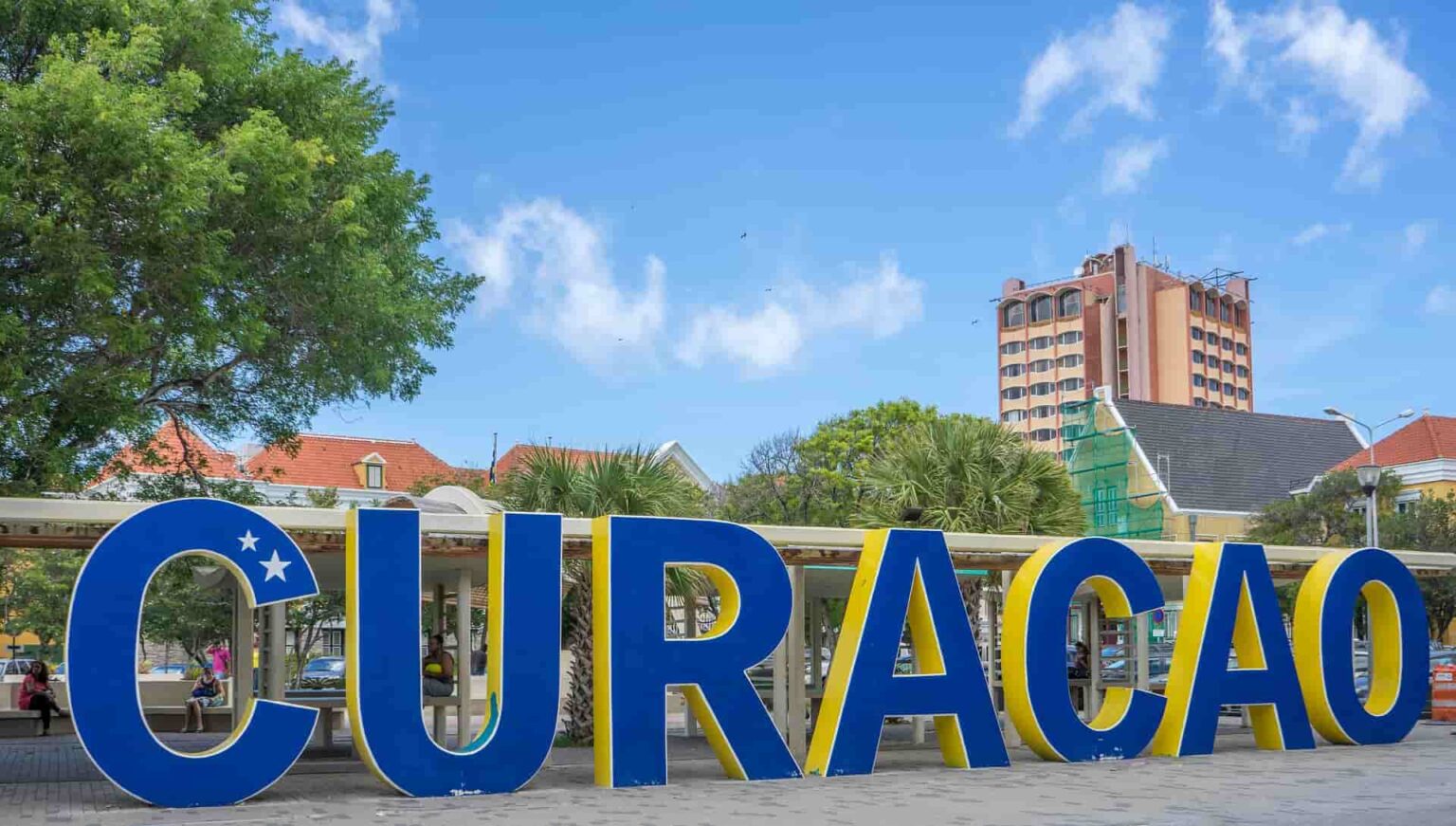

0 Comment